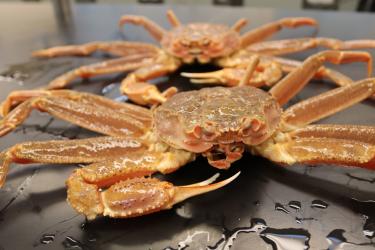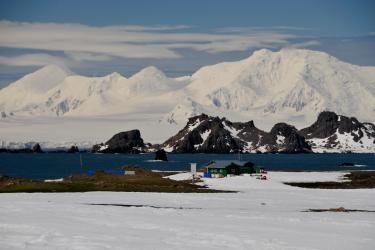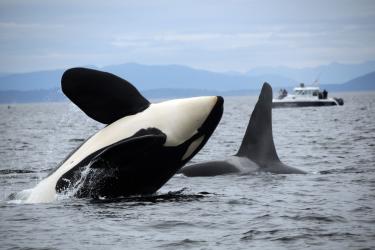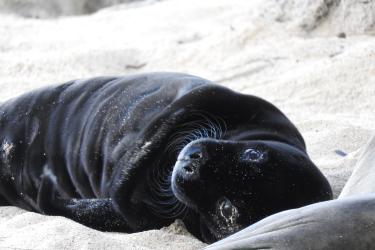Dam Removals Boost Atlantic Salmon Populations in Maine
0:00:00.9 John Sheehan: The Penobscot River in Central Maine is the second largest in New England and one of the last places in the US where you can still find the endangered Atlantic salmon.
0:00:09.7 Matthew Bernier: Atlantic salmon, blueback herring, alewife, American shad, American eel, all of the sea run fish species that were here historically in the Penobscot River are still here, which is a rarity among northeastern rivers.
0:00:23.9 JS: The river and surrounding watershed is also the historic home of the Penobscot Nation, the indigenous people who have been there for thousands of years and who have watched as in recent centuries, industrial development like mills and dams, polluted the watershed and caused fish populations to plummet.
0:00:40.5 Chuck Loring Jr.: Right now, nobody can fish for salmon, so that's one of the biggest connections that we've lost as people.
0:00:46.0 JS: Efforts to restore the watershed and clean up the river have picked up in recent decades. Thanks in part to NOAA programs like NOAA Habitat Focus areas, which includes the watershed and Species in the Spotlight, which includes Atlantic salmon, but new federal funding is about to give those efforts a supercharge.
0:01:06.0 JS: This is Dive In with NOAA Fisheries. I'm John Sheehan, and today we'll hear about the restoration of the Penobscot Watershed made possible by partnerships with the Penobscot Nation and others, and now funded in a way that will hopefully create meaningful change for the species and people who live there.
0:01:22.5 CJ: Just really excited about the amount of work that we're seeing line up right now. It's daunting at the same time, but...
0:01:28.6 JS: Daunting because there's so much to do?
0:01:31.3 CJ: Yeah, yeah. [laughter]
0:01:32.4 JS: This is Chuck Loring Jr. A member of the Penobscot Nation and its director of Natural Resources. The Penobscot Nation is a longtime partner with NOAA Fisheries and is one of the recipients of funding opportunities made possible by the Bipartisan Infrastructure law and the Inflation Reduction Act.
0:01:50.8 MB: Basically, the first round of funding that we got increased our funding at least tenfold over our previous levels. We went from having tens of millions of dollars to hundreds of millions of dollars.
0:02:02.5 JS: And this is Matthew Bernier, a marine habitat resource specialist in NOAA Fisheries Restoration Center in the Office of Habitat Conservation.
0:02:10.2 MB: And those projects include the removal of dams, replacement of undersized culverts with fish friendly road crossings like bridges, construction of fish ways, and the restoration of coastal habitats like salt marshes. The goals of the IRA funding are to restore historic habitat and increase the resiliency of communities to climate change effects like sea level rise and larger and more frequent storm events, especially for tribal and underserved communities.
0:02:37.0 JS: The Penobscot River once brought millions of migratory fish from the Gulf of Maine to the spawning grounds of Maine's interior. The watershed supported hundreds of thousands of Atlantic salmon and millions of herring and shad. Today, not so much.
0:02:53.7 MB: The first abuses of the Penobscot River go all the way back to the logging days when Bangor, Maine was considered the lumber capital of the world in the headwaters and logs were driven downstream to mills. So there was a lot of damming, a lot of bank erosion. Logs went to mills in the Bangor area. They were sought up and then sent to cities all over the East Coast. The Penobscot River was the home of the first chemical pulping plant paper manufacturer in the United States. And so that was a legacy that persisted for a long time with those discharges going straight to the Penobscot River. And if that wasn't enough, early in the 20th century when a lot of the communities started to be electrified, there was a big push to use the Penobscot River for hydroelectric generation. So we started to see dams either being converted to hydroelectric generation or new dams, and that persisted even late into the 20th century when new dams were being proposed.
0:04:00.2 JS: Yeah. All of this doing some pretty significant damage to the fish and not to mention the people that lived along the river, the Penobscot Nation. Chuck, can you tell us a little bit about the Penobscot Nation? How long have you been there?
0:04:17.2 CJ: Well, they like to say since time immemorial. There's definitely some historical artifacts dating back 10,000, 12,000 years in this region. We were once pretty numerous, but throughout history we've kind of dwindled down and now we're sitting around, I think 2,400 in the nation. About two thirds of us are still located in Maine within the watershed. So we relied on the river for not only providing subsistence in the form of fish, but also providing for transportation via canoe to areas within the watershed and beyond.
0:04:49.3 JS: And so a major focus of the new funding is reconnecting communities with their traditional lifelines. Can you talk about how those traditions and parts of your culture have kind of gone away?
0:05:02.5 CJ: Yeah. I mean, we think of all species in the natural world as being our relatives and the salmon not being here has definitely hurt us. I feel like that's one of the larger causes of some of the disparity that you see across Indian country is just that we're all disconnected from certain aspects of our culture or our relations, including the fish and wildlife that once roamed the area, whether it's buffalo or Atlantic salmon. And I think that's a really hard thing to bring back once you've lost that connection. We try to participate in as much as we can with the releases of Atlantic salmon, and I try to encourage our staff to be able to get out there, and put their feet in the water and hands on the fish to be able to just get connected with these fish that are essentially related to us through time. I mean, they're the same genetic variation that came from the Penobscot River. They're of that genetic strain.
0:06:00.1 JS: In recent decades, the conditions on the Penobscot have seen some improvement.
0:06:03.6 CJ: In over the last two decades we've lost two of the significant paper mills along the river. That has cleaned up the river substantially on top of all the other work that went on to the monitoring and holding them to their discharge limits. And another aspect of it that is worth talking about in the last couple decades here is the Penobscot River Restoration Trust and the Penobscot River Restoration Project in general, removing two main stem dams, creating a state-of-the-art fish bypass around another dam, and then installing a fish lift at Milford. With all that work going into it, the water quality has improved drastically in the river. The fish passage is, although it's still a work in progress, has improved drastically as well.
0:06:50.8 MB: I was gonna just touch upon something that Chuck said, which was the Penobscot River Restoration Project, which involved NOAA funding and technical assistance, and it resulted in the removal of the two lower most hydropower dams on the river. That really was a catalyst for a lot of the work that we're doing now throughout the watershed because those two dam removals really only open the historic habitat for two species, short nose sturgeon and Atlantic sturgeon. All of the other sea run fish, including Atlantic salmon, want to get to other places in the watershed and it's a very large watershed. So after those projects happened, then we were able to look, see a lot of problems upstream with barriers like culverts and dams. Even after the Penobscot River restoration project, NOAA was pretty fortunate that in 2011, several habitat focused areas or HFAs were designated throughout the United States, and the Penobscot River was one of those initial HFAs.
0:07:56.1 MB: And through that work we had funding partnered with the Nature Conservancy to work on some of these upstream projects. And we ended up doing a lot, especially to restore one of the sea run species, the alewife to their historic pond and lake spawning habitat. And through the HFA was when we started working a lot more closely with the Penobscot Indian Nation. And through that work and just that being a great collaboration and those projects being successful, we were able to build on that and really become a more involved partner with the tribe.
0:08:37.6 JS: Can you tell me a little bit more about that collaboration and how it works and how you're able to incorporate partner knowledge, especially partner knowledge of their home region?
0:08:49.3 MB: One of the things that we work with the tribe on is their traditional ecological knowledge. And for NOAA, what that means is placing our work, whether it's restoration or scientific studies in the context of the tribe's 10,000 year plus relationship with Atlantic salmon and other sea run fish. This history obviously predates NOAA as an agency and authorities like the Endangered Species Act and goes back to a time even before the United States existed as a country. It's a bit of a misnomer to think that the tribe only brings traditional ecological knowledge to the table. They bring that and more because we do a lot of collaboration. We work through cooperative agreements where we're providing funding, but in all respects, we're partners and it's all phases from getting these things planned, doing feasibility studies, engineering design, permitting, and ultimately construction and monitoring of these projects.
0:09:53.5 CJ: We're in a fortunate position where we're doing a lot of work on our own land base, and I think all of our partners are pretty respective of that. And we've done our own homework and I did a stream crossing analysis for all of our lands as a forester because fish passage and moving water through our road systems was a big priority for the nation. And that's been really helpful I think, in helping us not only prioritize fish passage, but also to kind of arm ourselves against what we're seeing for climate here.
0:10:28.4 JS: And that was another part of the funding specifications, right, is doing restoration in service of climate resilience.
0:10:37.4 CJ: Definitely. And that's really important for everybody right now. I mean, we've seen a lot of devastating storms come across the state even this past winter, but I can think back to 2017 was when I really noticed it. I really realized that there's definitely, this weather isn't normal.
0:10:57.2 MB: It's also important to remember that Atlantic salmon are a cold water species. And what's great about the Penobscot River is that the Penobscot has a very large watershed and most of it is still intact and undeveloped. It's largely forested and has high elevation headwaters. So this makes it resilient to the effects of climate change, like increasing air and water temperatures.
0:11:23.2 JS: Chuck, you said that you take a seven generation approach to conservation. Can you explain that?
0:11:30.4 CJ: Yeah. I mean, it's kind of something across Indian country that's taking hold. We're looking to protect our relatives here out seven generations and what that looks like, that's, it's a long-term projection. So we're talking about not just from our kids or our grandkids or our kids' grandkids. Seven generations you're talking down the line quite a ways and hope that this restoration work takes hold and we can kind of bring fish back for that generation or at least preserve what we have.
0:12:01.3 JS: I thought it was a nice sort of a visualization because it's both a very, very long time, but it's also very specific.
0:12:08.9 CJ: Absolutely. Yeah. We're not just a family landowner that might have land here for a couple hundred years and then who knows what's gonna happen. We'll sell out to a team owner or a REIT down the road and cash in on it. We're gonna be here forever. I mean, that's what we're working towards is protecting what treaty rights we have left as well as trying to preserve more hunting rights and to be able to help our people persevere and practice traditional life ways as best we can. You think about if you have kids or even nieces and nephews, you think about what you're leaving to them, but it's hard not to think about what else we're leaving to the successors of the successors of the successors that as we go on, we've seen a lot of changes over the world in the last... My ancestors have over the last 10,000, 12,000 years. It is refreshing to kind of think about, Hey, we need to do what we're doing sustainably.
0:13:02.1 JS: You mentioned how some previous projects have opened up more projects essentially. You now know what additional work needs to be done, and I'm interested how this current funding is going to be able to inform work decades from now.
0:13:19.8 MB: The large amount of funding that we have means that we've been able to take on more projects, larger projects, and more complex projects, including Fish Passage. And some of these projects have alluded restoration practitioners for decades due to their scope and cost. So as I like to say, is success builds upon success. So the more restoration projects we complete, the more confident we are to take on more projects, bigger projects, and more complex projects. And we're getting through the bucket list of projects that alluded other fisheries professionals for generation after generation, and that really feels great. So I'm truly inspired to work with partners like the Penobscot Tribe.
0:14:08.6 JS: Given sort of these recent successes, are you optimistic in the near term? I mean, does it feel like you're closer to seeing some goals accomplished?
0:14:22.0 MB: Well, today, even in a good year, the Penobscot River probably sees only about 1% of the adult salmon returns that the river saw historically. And if you think about what that decline meant to tribal sustenance fishing and later to commercial fishing and recreational fishing, it was a very abrupt and tragic decline. And all of the other sea run fish were in very, very low numbers as well. But what's really remarkable is that unlike other rivers in New England, these fish were not extubated completely. They didn't disappear. And so that gives us hope and we're seeing the numbers rebound. So that's really encouraging. And I think the lesson, one of the lessons from the Penobscot is that it's been one daunting challenge after the other. I mean, Chuck mentioned the water quality challenges that we had before, and then after we got through that, it turned into fish passage challenges.
0:15:27.1 MB: We're facing a big challenge now with climate change as well, but because we could make progress on water quality because we could make progress on fish passage, that gives me hope that we can make progress on climate change issues as well. And especially if we, I think about the seven generation thinking like the tribe has. It took probably about seven generations to really trash the river and get to this point where we're starting to finally turn the corner and turn things around. So we have at least seven more generations of work to do here.
0:16:06.4 JS: Can you sort of describe the importance of the other fish species to the overall system, the importance of alewife and river herring?
0:16:16.7 CJ: The presence of river herring in general, coming back into the river has helped kind of clean up some of the area lakes. It's been a moving story and a really helpful story to kind of help quantify the impacts of the Penobscot River Restoration Project. With river herring, we're seeing exponential increases year after year, so it'll be really interesting to see what happens this year. But last year we saw almost 6 million fish, and I think the year before that we were in around 2 million. We're really seeing exponential increases with those fish species, and that's one of the traditional species that the tribe had consumed before, but also utilized for fertilizer in gardens and just because they were so plentiful.
0:17:01.6 MB: Yeah. And if you look at last year for alewives in particular, the Penobscot run of over 5 million fish made the Penobscot the largest run of alewives along the entire East Coast for their historic range from Maine to Florida, which is pretty significant and is a really great success story.
0:17:22.9 CJ: And they bring back some really large fish that we are able to catch and the striped bass, which is a welcome friend back.
0:17:29.2 JS: Yeah, I was gonna ask. The improving water quality must have implications up the food chain, right?
0:17:36.0 MB: Yeah, it's absolutely. And if you look at bald eagle numbers, especially on these rivers where we have large alewife runs have just exploded in recent years because the alewives are primary forged species for these and all kinds of other wildlife.
0:17:53.4 CJ: Definitely. It's really neat to go to an area where they're having a little bit of a hard time passing through like at Leonard's Mills site and see the sign of the raccoons down there getting alewife and then going to another area where they're penned up and having a hard time passing at a dam. And you'll see the striped bass in there feeding on 'em. And I've had some, I won't say where, but I've had some pretty amazing mornings on the river, 4:30 AM with the light just coming up, and you can hear the striped bass popping at the alewives and throwing a fly to them is probably, it's not quite salmon fishing, but it's definitely one of the highlights of my year just for that reason.
0:18:40.1 JS: Matt Bernier and Chuck Loring, thanks so much for talking with me.
0:18:43.2 CJ: Thanks. Good to be here.
0:18:44.1 MB: Thank you.
0:18:45.1 JS: Chuck Loring Jr. Is a member of the Penobscot Nation in Maine and the tribe's Director of Natural Resources. Matt Bernier is a Marine Habitat Resource Specialist in NOAA Fisheries Restoration Center in the Office of Habitat Conservation. You can find more on the Penobscot River restoration efforts and how other funding from the Bipartisan Infrastructure Law and Inflation Reduction Act are supporting fish passage and habitat restoration at our website, fisheries.noaa.gov. I'm John Sheehan, and this has been Dive In with NOAA Fisheries.
Close







